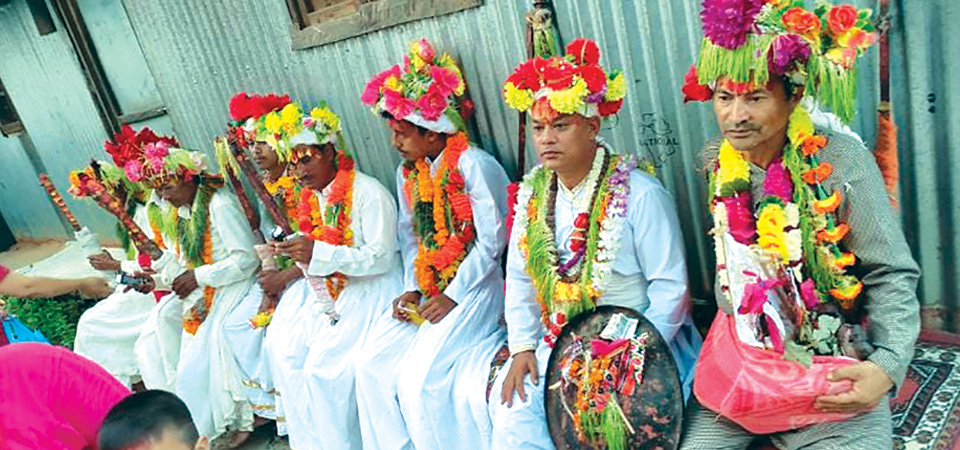Khadga Jatra management becoming difficult

By Baburam Sharma
Dolakha, Oct. 20: Khadga Jatra, which is traditionally celebrated every year in the historical city of Dolakha, faces a shaky prospect due to the shortage of funds.
After the establishment of the democratic republic, the operators of Guthi stopped paying their dues and there is a financial crisis to conduct this fiesta.
Treasurer Suresh Kumar Shrestha said that Bhimeshwar Puja and Guthi Management Committee provided assistance of Rs. 45,000 for the operational management.
Since the death of King Indradev Singh of Dolakha in 1590 BS, this procession had been organised with the fund of the Guthi operators. For a few years, the procession was held with personal contribution. Now the money that comes from sacrificial offerings to Bhimeshwar is hardly enough. The tradition will be stopped one day if there is no support from Guthi committees.
Former chairperson of the committee Jeevan Shrestha expressed grief over the government's failure to carry out the procession without bearing any responsibility.
According to the tradition, the day after Bijaya Dashami (Ekadashi day) is marked by celebration from morning to evening.
During the procession, the youngest to elderly people dance wearing white daura-surwal, jama, garland of yellow jamara, the local kusule baja (traditional music), wielding swords.
According to the legend, after the demons started tormenting the gods and humans in various ways, a meeting of the gods on how to kill the demon king Mahishasura made the decision to fight the demons.
It is said that on the first day of the war, the gods and goddesses reached Kalinchok Bhagwati at an altitude of 3,842 metres above sea level with various invitations and initiation for war.
After receiving the assurance, the gods and goddesses started the Yagya in front of Tindhara at a place called Raiti in Dolakha city. It is believed that the war between the gods and the demons started after the demons came there and trampled the Yagya mandapa.
It is said that on the last day of the war, on the day of Vijaya Dashami, the gods and goddesses achieved victory by killing Mahishasura.
To celebrate this occasion, the priests make a statue of Chakreshwar Baliraja from rice on the day of Nawami at Chakra Dabali, a little below the place of Rajkuleshwar Lower Secondary School. Four bullocks were sacrificed at Bhimeshwar in Kalratri.
On the day of Tika, white gourd is cut in the name of Mahishasura while performing the battle with Bajagaja in the evening as he has to go to war but has to be busy with Tika on that day.
On the morning of Ekadashi, the war starts again. Among those participating in the battle are the original sword-wielding man and his bodyguards, three among sisters, who was called for war, and Yakargattha Basal, who will be the minister and general, and Bhimwali carrying a person with him.
After the Yakargattha general signals them to leave the battle with a sword, the dance of war performance starts from the Rajkuleshwar Temple accompanied by traditional music.
After feeling tired during the war, the army with its troops go to Balkumari of Pingal Tole for help and after getting help from Balkumari, the warriors reach Bhimeshwar Dober Dabali and the war starts again.
Four monsters were found there. As a symbol of that, the practice of killing four buffaloes with a sword is still going on.
In this way, the advancing army reached Tripurasundari via the temple of Kali and asked for help and Tripurasundari Bhagwati told the minor Vatukbhairav how to fight and put a bell, a drum and a sword in his hands and a garland of he-buffalo’s Ranga's intestines, according to legend.
The head of a calf sacrificed at Bhimeshwarasthan, Tripurasundari is kept here and it is beheaded by Rajkuleshwar Bhagwati and Batukbhairav with a sword. After this, it is customary to celebrate by playing the sagun baja.
According to local Tirthanarayan Joshi, it is still customary for the priests of Tripurasundari and Rajkuleshwar to sit in front of the temple in the evening.
Joshi says that the government should take initiative for the protection of the Jatra as it is the oldest of the Puranic Jatras, which were held during the time of Malla and Kirat Dynasty 500 years ago.
Recent News

Do not make expressions casting dout on election: EC
14 Apr, 2022
CM Bhatta says may New Year 2079 BS inspire positive thinking
14 Apr, 2022
Three new cases, 44 recoveries in 24 hours
14 Apr, 2022
689 climbers of 84 teams so far acquire permits for climbing various peaks this spring season
14 Apr, 2022
How the rising cost of living crisis is impacting Nepal
14 Apr, 2022
US military confirms an interstellar meteor collided with Earth
14 Apr, 2022
Valneva Covid vaccine approved for use in UK
14 Apr, 2022
Chair Prachanda highlights need of unity among Maoist, Communist forces
14 Apr, 2022
Ranbir Kapoor and Alia Bhatt: Bollywood toasts star couple on wedding
14 Apr, 2022
President Bhandari confers decorations (Photo Feature)
14 Apr, 2022











